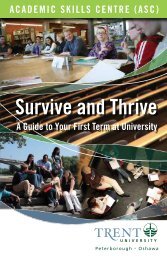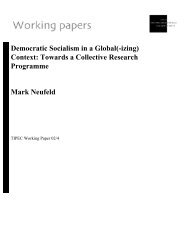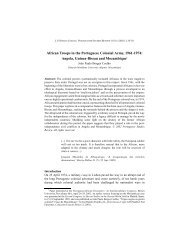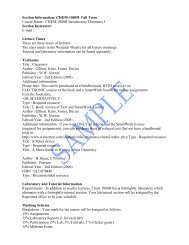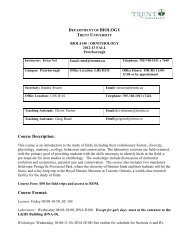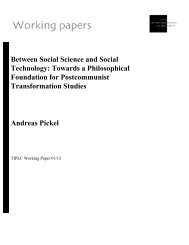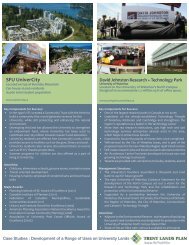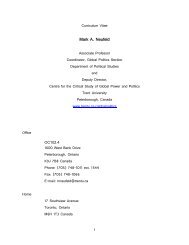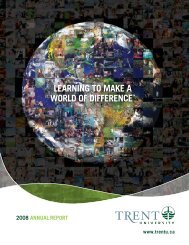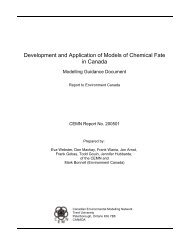AUTHOR COPY - Trent University
AUTHOR COPY - Trent University
AUTHOR COPY - Trent University
You also want an ePaper? Increase the reach of your titles
YUMPU automatically turns print PDFs into web optimized ePapers that Google loves.
Original Article<br />
Conceptualizing holism in international<br />
interdisciplinary critical perspective:<br />
Toward a framework for understanding<br />
holistic health<br />
Farah M. Shroff<br />
Department of Family Practice, <strong>University</strong> of British Columbia, Vancouver BC, Canada.<br />
E-mail: fmcshroff@gmail.com<br />
Abstract The concept of holism is defined in disparate ways. This article offers<br />
foundational understandings of this term from various parts of the world, illustrating the<br />
virtually universal, historical, as well as contemporary nature of ideas such as interconnectedness,<br />
unity and oneness. Throughout human history, holistic worldviews were<br />
dominant until the past 400 years or so. At present, a revival of holistic thought-forms is<br />
taking place in many parts of the world. The purpose of this article is to sketch the<br />
landscape of holistic philosophical foundations, discuss systems science in this context<br />
and apply these underpinnings to holistic health in the hope that it will increase our<br />
understanding of both the conceptual foundations of holism, as well as its applications<br />
to health promotion, disease prevention, treatment of ill health and palliation. The<br />
article will conclude with the recommendation that holistic health-care practitioners<br />
take social inequities into account, so that this integrative health-care can become a<br />
means for individuals to take action for wellness, as well as a means to create structural<br />
changes toward equitable resource distribution.<br />
Social Theory & Health (2011) 9, 244–255. doi:10.1057/sth.2011.6;<br />
published online 8 June 2011<br />
<strong>AUTHOR</strong> <strong>COPY</strong><br />
Keywords: holism; mind-body; interconnection; systems science; interdisciplinary;<br />
international<br />
Introduction: Principles of Holism<br />
The words health and holistic are semantically related. They both stem from the<br />
same root word: the Anglo-Saxon words whole, hale and holy (Pretorius, 2009).<br />
Despite the linguistic connection, the word holistic is used in incongruent<br />
ways and has become an umbrella term that is used to encompass anything<br />
r 2011 Macmillan Publishers Ltd. 1477-8211 Social Theory & Health Vol. 9, 3, 244–255<br />
www.palgrave-journals.com/sth/
Conceptualizing holism in international interdisciplinary critical perspective<br />
that is non-reductionist or dualist. Holism is sometimes spelled as wholism, to<br />
accentuate the semantic connections of this word to the word ‘whole’. In this<br />
article, the concept holistic health-care will be used interchangeably with<br />
alternative or complimentary medicine and will be defined as approaches to<br />
well-being and treatment of illness that focus on mind and body. In addition to,<br />
the term holistic health-care is used in this article to encompass both self-care<br />
and practitioner-based care. Holistic self-care encompasses practices such as<br />
yoga, meditation, Tai Chi and Chi Gung. Holistic care provided by professionals<br />
encompasses traditional Chinese medicine, ayurveda, homeopathy, botanical<br />
medicine, therapeutic massage and others.<br />
Holistic schools of thought vary from region to region, and throughout time, but<br />
have more similarities than differences. A number of principles unite them.<br />
One principle they have in common is that entities and systems in the universe,<br />
including humans, are considered part of a unified whole, which cannot be<br />
understood by the isolated examination of its separate parts (Dusek, 2006).<br />
These parts are actively interrelated. Similarly, matter is interlinked, interconnected<br />
and dynamic; it is constantly changing and it is this transformation that<br />
denotes time.<br />
Holistic worldviews do not focus exclusively on the body or organism, but on<br />
the larger world – the universe – and are often associated with spiritual or<br />
religious thought-forms. At the heart of holism, there is an awareness of the<br />
unity and mutual interrelation of all things and events. All things are seen as<br />
interdependent and inseparable. This ultimate, indivisible reality is called<br />
Brahman in Hinduism, Dharmakaya in Buddhism and Tao in Taoism. As it<br />
transcends all concepts and categories, Buddhists also call it Tathata-Suchness<br />
(Deshmukh, 2006), That Which Is, or Is-ness, the sum of all forms.<br />
In Hinduism, we find a similar emphasis: ‘a fundamental Hindu principle<br />
is one of Unity of all created things. Behind diversity, there is unity. Behind<br />
individual souls, there is the Self, one with the Divine. Not only human life but<br />
all created life including animal life is a unity. We spring from one source.<br />
Differences and divisions are unreal. The belief that we originate from one<br />
common source has ethical implications: it leads to a kinder and a gentler<br />
world’ (Goel, 2006). One of the Hindu texts, the Isa-Upanisad states: ‘[b]ut<br />
he (sic) who beholds all beings in his (sic) own Self, and his (sic) own Self in all<br />
beings, does no longer hate (vijugupsate)’ (stanza 6).<br />
These views are also echoed in other traditions. According to African holistic<br />
views, for example, the cosmos is one, a spiritual totality. Spirit is not separate<br />
from matter, as everything is connected (Asante and Mazama, 2009). In African<br />
holistic thought, all things are considered to be related through one divine force<br />
(Asante and Mazama, 2009). They are alive, giving and receiving energy, with<br />
all life and matter created for a specific purpose.<br />
<strong>AUTHOR</strong> <strong>COPY</strong><br />
r 2011 Macmillan Publishers Ltd. 1477-8211 Social Theory & Health Vol. 9, 3, 244–255<br />
245
Shroff<br />
First Nations philosophies are similar. First Nations peoples see themselves as<br />
part of a Sacred Hoop or Circle of Life, not having control over it; they are<br />
careful to maintain a balance with life (Hunter et al, 2006). Just as we impact<br />
the broad cultural climate in which we live, our physical, emotional and psychological<br />
health is influenced by that very climate. Social harmony thus influences<br />
individual well-being in many First Nations cosmo-visions. First Nations<br />
healers advise people to see everyone as a family member or friend thus<br />
encouraging social integration (Musqueum Elder Shane Pointe, 5 November 2006,<br />
personal communications). The Medicine Wheel, representing harmony and<br />
connectivity, takes this concept further. It represents all of creation: all planets,<br />
stars, peoples, animals and plants. It is the basis of community health with the<br />
circle symbolizing the cycles of the seasons and of life, and wholeness and perfection.<br />
First Nations peoples’ healing circles, sweat lodge ceremonies and other<br />
healing rituals are generally performed in a circle. The circle emphasizes togetherness<br />
and community unity, without which the individual cannot be well.<br />
Systems science<br />
These ancient principles are also present in some fields within contemporary<br />
science. Francisco Varela, for example, observes that Buddhist ideas are prevalent<br />
throughout our Western culture – in physics and biology, for example,<br />
the basic ideas are Buddhism in disguise (Lee, 2006). During the past few<br />
decades, scientists from various disciplines, such as Ilya Prigogine, Erich<br />
Jantsch, Gregory Bateson, Humberto Maturana and Manfred Eigen, have developed<br />
emerging systems views of the world and made the study of living systems,<br />
organisms, social systems and ecosystems their focus.<br />
The systems view focuses on integration and relationships and sees systems<br />
as integrated wholes whose properties cannot be reduced to its smaller units.<br />
Every organism, from the smallest bacterium to plants, animals and humans, is<br />
integrated and considered as living systems. Families and communities are also<br />
considered as systems. Gregory Bateson (1972), for example, was interested in<br />
studying patterns, which connect crabs to lobsters, orchids to humans and in<br />
seeing the interrelatedness of life forms. For hundreds of years, much of<br />
Western science concentrated on isolating the world’s basic building blocks.<br />
Now that this has been achieved to some extent, the systems approach emphasizes<br />
principles of organization (Kineman and Kumar, 2007) creating a more<br />
ample understanding of matter, from macro- and micro-perspectives. Systemic<br />
properties are lost when a system is dissected, either physically or theoretically,<br />
into isolated elements. Although it is possible to discern individual parts in<br />
any system, the nature of the whole is different from the mere sum of its<br />
parts (Kineman and Kumar, 2007). This understanding ties in very well with<br />
principles of holism and holistic health.<br />
<strong>AUTHOR</strong> <strong>COPY</strong><br />
246 r 2011 Macmillan Publishers Ltd. 1477-8211 Social Theory & Health Vol. 9, 3, 244–255
Conceptualizing holism in international interdisciplinary critical perspective<br />
The New Physics<br />
Connected to systems science, some physicists also make connections between<br />
their work and holistic thought-forms. Notable physicists such as David Bohm<br />
and Fritjof Capra emphasize the similarities between their theories of the indistinguishability<br />
of field and force and mind and matter, with the spiritual traditions<br />
of Buddhism, Confucianism, Hinduism and Taoism. Over the past 2000<br />
years or more, Buddhists have developed sophisticated philosophical, phenomenological<br />
and epistemological ideas, and they have found a very practical<br />
way to apply them (Lopez, 2008). Some Western scientists, such as those who<br />
study the mind, have been profoundly influenced by Buddhist thought and<br />
have worked to establish empirical correlations between Buddhist practice and<br />
scientific work (Lopez, 2008; Weaver et al, 2008). Western tradition has avoided<br />
the idea of a selfless self, of a virtual self. This egolessness, or selflessness, is at<br />
the very core of Buddhism.<br />
Capra (2002) also extends the framework of systems and complexity theory to<br />
the social domain, akin to the foundational principles of holism. He uses this extended<br />
framework to discuss some of the critical issues of our time – the management<br />
of human organizations, the challenges and dangers of economic globalization,<br />
the scientific and ethical problems of biotechnology, and the establishment of ecologically<br />
sustainable communities and technologies (Capra, 2002).<br />
Bohm conceptualizes an implicate order to the universe composed of frequencies<br />
beyond time and space that has been hidden from people. His paradigm is<br />
a form of ontological holism. In this conception of order, primacy is given to the<br />
undivided whole, and the implicate order inherent within the whole, rather than<br />
to parts of the whole (Healey, 2009).<br />
These scientists emphasize in their work the same notions as holism; the<br />
whole is greater than the sum of its parts. The natural world interacts synergistically.<br />
It is thus not possible to fully understand systems by knowing the<br />
properties of their individual components – although it is useful to study individual<br />
components. Indeed, as stated by Capra,‘the basic oneness of the universe<br />
is not only the central characteristic of the mystical experience but it is also<br />
one of the most important revelations of modern physics. It becomes apparent<br />
at the atomic level and manifests itself more and more as one penetrates deeper<br />
into matter, down into the realm of subatomic particles’ (Gaan, 2005, p. 324).<br />
The observer of a scientific experiment, according to quantum theory, can<br />
change the outcome of an experiment, simply by observing, for the observer<br />
puts energy into the system and this energy has an impact on that, which is<br />
being observed. Just as Buddhist and Hindu philosophy stress, the observer<br />
and observed are seen as connected, as are mind and matter, field and force.<br />
As Gary Zukav explains, quantum theory sees everything in the universe as<br />
<strong>AUTHOR</strong> <strong>COPY</strong><br />
r 2011 Macmillan Publishers Ltd. 1477-8211 Social Theory & Health Vol. 9, 3, 244–255<br />
247
Shroff<br />
related and interrelated at the most subatomic level, making it impossible to<br />
observe reality without altering it (Edmison, 2004).<br />
The new physics thus emphasizes the interrelational, indeterminate and<br />
probabilistic qualities of matter and energy, and challenges components of the<br />
scientific method related to Newtonian mechanics, such as determinism and<br />
linear causality.<br />
New science and holistic health<br />
Some physicians are moving beyond these ‘old’ scientific paradigms, however,<br />
in conceptualizing health issues (McQuaide, 2005). Although there are literally<br />
thousands of allopathic physicians whose work incorporates ideas of holistic<br />
health, Deepak Chopra, MD, and Andrew Weil, MD, have gained great popularity.<br />
Their work has successfully bridged a gap between reductionism and<br />
holism and, drawing from quantum mechanics theory, has conceptualized the<br />
differences between a reductionist and quantum or holistic paradigm for health.<br />
These allopathic physicians with holistic inclinations predict that sooner or<br />
later, allopathic medical science will catch up with the theoretical revolution in<br />
physics – as the interdependence of mind and matter is now firmly established<br />
in the model of reality used by contemporary physicists; these physicians assert<br />
that medical researchers ought to seriously take up the research challenge of<br />
analyzing how the mind and body interact.<br />
A relatively new branch of scientific inquiry, psychoneuroimmunology, has<br />
taken up this challenge. It integrates some of the ideas from quantum mechanics,<br />
psychology, neurology and endocrinology. Psychoneuroimmunologists primarily<br />
theorize the mind/body connection through studying the brain and hormones.<br />
Hormones, particularly those from the brain, are seen as the link between the<br />
mind and body. Candace Pert made headlines with her 1970’s research on<br />
neuropeptides as the ‘molecules of emotion’ and was also featured in the film<br />
What The Bleep Do We Know (2004) (Bruce, 2005). Pert’s research was posited<br />
on the presumption that neuropeptides are the molecular messengers that affect<br />
the metabolism of the cell and link the nervous, immune and endocrine systems<br />
(Pert and Marriott, 2007). Pert’s contributions have given birth to a large number<br />
of such studies within the reductionist scientific community.<br />
<strong>AUTHOR</strong> <strong>COPY</strong><br />
Holistic health<br />
The aforementioned concepts of systems science and holism find concrete application<br />
in systems of holistic health promotion, disease prevention, treatment<br />
of illness and/or palliative care such as yoga, ayurvedic medicine, Chi Gung,<br />
Tai Chi, Traditional Chinese Medicine and African and Indigenous systems of<br />
health-care. What connects the diversity of these holistic traditions is that<br />
without exception, they take into account mind, body, the environment and the<br />
248 r 2011 Macmillan Publishers Ltd. 1477-8211 Social Theory & Health Vol. 9, 3, 244–255
Conceptualizing holism in international interdisciplinary critical perspective<br />
interconnection between them. They recognize the interrelationship between<br />
human health and the social and physical environment. Holistic health theory is<br />
posited on the notion that life force (or prana (in Sanskrit), chi (in Chinese),<br />
mana (in Hawaiian) connects all life in the universe, and that this energy is<br />
responsible for the life of all beings. Prana is that which gives us life, or the<br />
vehicle of life, the cosmic breath, the rhythmic oscillation effective on all levels<br />
of conditioned existence. Restoring and keeping this life force flowing is one<br />
way of keeping people healthy.<br />
We may typify holistic health with various characteristics such as the notion<br />
that health is a positive state, not merely the absence of disease, and that health is<br />
tied closely to familial, social and cultural environments. Holistic health-care is<br />
also characterized by the belief that successful healing transforms the practitioner,<br />
as well as the client and that healing includes a spiritual component in the etiology<br />
and treatment of illness. Holistic health-care understands malfunctions (illness) in<br />
the context of the social, cultural and spiritual environment. Treatment of both<br />
body and mind are considered integral (Barnes et al, 2004).<br />
Tibetan medicine is similar. Religious rituals such as prayer are central for<br />
both the practitioner and patient. Because of the sacred nature of healing,<br />
Tibetan doctors of yore did not charge for their service (Dunkenberger, 2009).<br />
Such religious, spiritual and social aims of healing are combined in many<br />
systems of holistic health.<br />
The body is understood in a unified manner within holistic health perspectives.<br />
Injury to one part of the body may thus damage another, seemingly unrelated,<br />
part. Kidney malfunctioning, for example, may result from a damaged heart.<br />
If one part of the kidney is injured, another part may take over its functions.<br />
Holistic principles maintain that the body has an innate capacity to heal itself,<br />
and the role of the physician is to first do no harm and second to assist the body<br />
in its natural tendency toward balance. Andie Knutson (1961) declares:<br />
<strong>AUTHOR</strong> <strong>COPY</strong><br />
Many of the ills of modern society stem from attempts to deal with men<br />
(sic) segmentally rather than with men (sic) as a unit. Specialization,<br />
which seems to be an inevitable outgrowth of scientific advance, results in<br />
institutions competing with one another for various segments of a man<br />
(sic) who is seeking to maintain his integrity as a total being. How far<br />
removed we are from the medicine man (sic)! He has strengths that have<br />
not been duplicated in our modern society. (p. 1702)<br />
Despite the fact that Knutson was writing approximately 50 years ago, the<br />
segmentation, atomization and specialization of modern society continue to exist.<br />
More than 2300 years ago, the Greek philosopher Hippocrates emphasized<br />
that doctors should consider the whole human being in order to treat and<br />
diagnose. Included in the Hippocratic Oath is an allegiance to Hygeia, the<br />
r 2011 Macmillan Publishers Ltd. 1477-8211 Social Theory & Health Vol. 9, 3, 244–255<br />
249
Shroff<br />
Goddess of Good Health, who is synonymous with hygiene, disease prevention<br />
and therapeutic medicine (Capra, 2002). The Hippocratic Doctrine, which ostensibly<br />
underlies the basis for current allopathic medicine, stresses that: ‘the wellbeing<br />
of men (sic) is influenced by all environmental factorsythe quality of air,<br />
water and food, the winds and topography of the land’ (Maurer and Smith,<br />
2005, p. 597). 1 Although allopathic medicine has not generally been shaped<br />
by this complex view of health and disease, holistic concepts exist within<br />
allopathic theoretical frameworks. But theory is often not put into practice. This<br />
is, of course, true of all systems of medicine. However, allopathic doctors are<br />
increasingly using alternative medicine in their practices, and some allopathic<br />
doctors hire alternative practitioners to work in their offices. Increasingly,<br />
nurses, midwives and other health-care practitioners also incorporate holistic<br />
practices into their clinics.<br />
Holistic health-care: A growing trend<br />
Although allopathic medicine is useful for the treatment of acute and emergency<br />
care needs, holistic health-care appears to be more promising for chronic conditions<br />
and mental health-care, which constitute a majority of health problems,<br />
since chronic diseases are a leading cause of death and disability around the<br />
world. The interest in holistic care in North America is growing among health<br />
professionals and the general public. In the United States, for example, spending<br />
on alternative medicine has increased from 14 billion in the early 1990s to 21<br />
billion in 1997 (McQuaide, 2005). Moreover, 36 per cent of adults are using<br />
some form of holistic and alternative medicine (Barnes et al, 2004). If megavitamin<br />
therapy and prayer specifically for health reasons are included as well,<br />
that number rises to 62 per cent (Barnes et al, 2004). In Canada, that number is<br />
similar with one study finding that 73 per cent of Canadians have used some<br />
form of holistic health-care in their lifetime (Esmail, 2007). While studies measure<br />
different definitions of holistic health and varying time periods, Canadians<br />
are increasingly using holistic health-care.<br />
The popularity of holistic health-care is in part because of the increasing<br />
dissent with the present system of medical care delivery. Some people, particularly<br />
women, prefer holistic practitioners partly because of practitioner<br />
friendliness and interpersonal sensitivity (Kelner and Wellman, 1997; Barnes<br />
et al, 2004). Fewer side effects, the perceived lack of harm from holistic healthcare<br />
and the possibility of improved health are other reasons why Canadians are<br />
turning to holistic health-care practices (Quan et al, 2008).<br />
<strong>AUTHOR</strong> <strong>COPY</strong><br />
Holistic health-care critically examined<br />
It is precisely because of their growth and interest that holistic models also need<br />
to be considered critically. Most systems of holistic health are overly concerned<br />
250 r 2011 Macmillan Publishers Ltd. 1477-8211 Social Theory & Health Vol. 9, 3, 244–255
Conceptualizing holism in international interdisciplinary critical perspective<br />
with the individual and her/his mind, body and spirit, but rarely examine the<br />
health connections to the larger social world (Shroff, 2000). This is probably<br />
the most astute criticism of holistic health-care. Most systems of health-care,<br />
including holistic ones, do not include social health as a major component. This<br />
lack of attention to public health-care is a serious gap in holistic health-care<br />
practices. Furthermore, within many systems of holistic medicine, patriarchal<br />
and classist overtones are apparent. In ayurveda, for example, some interpretations<br />
of tridosha theory (which notes different body/mind types among<br />
people) have likened vata (the air/ether type) to the Brahmin caste and portrayed<br />
vata people as noble, whereas kapha (the earth/water type) is portrayed as<br />
docile and slow, as the ‘ideal’ Indian woman ought to be. In Chinese medicine,<br />
yin traditionally means the shady side of a mountain, but is also related with<br />
femaleness; under a patriarchal lens, yin and women are considered sinful. For<br />
Taoists, there is no such thing as absolute moral judgments, with neither Ying<br />
nor Yang representing good or bad (Brodd, 2009). Although this reasoned view<br />
(which states that neither yin nor yang is good or bad) is probably the original<br />
medical understanding, oppressive structures have affected modes of thinking.<br />
Most likely, the original writings were not corrupted by hierarchical social<br />
structures, but have over time, given that medicine and politics are intricately<br />
intertwined, been politicized. Upper class, patriarchal and heterosexist interpretations<br />
of holistic health concepts flourish in the literature (Lu, 2005; Lad,<br />
2006; Liao, 2006; Lad and Durve, 2008; Gyatso and Hakim, 2010).<br />
Furthermore, holism has been embraced by several groups, including those<br />
who serve non-holistic ends. Among them are ‘new age’ entrepreneurs who are<br />
profiting from the commodification of holistic health, including shamanic healing,<br />
hypnosis, trance work and so forth. Practitioners, who claim to be holistic, may<br />
excuse sexist, heterosexist, classist and racist behavior in the social organization<br />
of their work, on the grounds that the culture from which it comes is based on<br />
oppressive notions. This kind of appropriation and misrepresentation of holism is<br />
dangerous, as are the claims made by practitioners masquerading as holistic<br />
healers, stating that they can miraculously cure diseases in order to lure vulnerable<br />
and ill people into paying large sums of money for unproved therapies.<br />
Some aspects of these therapies are problematic when they fail to take<br />
into account power differences and their grafted relationship with race, class,<br />
gender, sexual orientation, ability, age and so forth. Some, such as Louise Hay,<br />
go as far as to suggests that people are 100 per cent responsible for creating their<br />
experiences (Dua, 2006). This completely negates the existence of hierarchies<br />
such as imperialism, racism, patriarchy, heterosexual dominance and so forth.<br />
Although it is pleasant to entertain the thought that individuals who create<br />
peace and harmony in their lives will have no (health) problems, it defies the<br />
experiences of many of us. There is always the danger of simplifying health and<br />
<strong>AUTHOR</strong> <strong>COPY</strong><br />
r 2011 Macmillan Publishers Ltd. 1477-8211 Social Theory & Health Vol. 9, 3, 244–255<br />
251
Shroff<br />
healing to a point where power relations are not taken into account. Unfortunately,<br />
this simplistic type of analysis pervades the New Age Movement’s rhetoric, which<br />
results in various forms of ‘victim blaming’ (Crawford, 2006).<br />
Although it is true that the New Age Movement emphasizes fitness, wellness,<br />
prevention and risk reduction, whereas downplaying the vast and ambiguous<br />
external forces that influence health, we must be cautious not to confuse New<br />
Age entrepreneurs with holistic health practitioners. The critique that holistic<br />
health provides an individualistic solution to problems of health by changing<br />
the individual rather than the social causes of illness rings true. Plus, the victimblaming<br />
ideology promoted by some holistic health-care providers shifts the<br />
burden of blame to the individual rather than the social context (Crawford,<br />
2006). Yet this critique applies to allopathic medicine as well. Allopathic<br />
medicine does not encompass a social and political view of the determinants<br />
of health either. In itself, it is not a solid enough argument to dismiss holism.<br />
It is, combined with the above arguments of appropriation and class privilege,<br />
a solid basis for dismissing the New Age Movement as opportunistic, however.<br />
In closing<br />
The concept of holism is international and ancient. Crossing countries and<br />
historical periods, holistic thought and health practices based on these thought<br />
forms flourished for centuries and declined over the past 400 years, in part<br />
because of the growth in reductionist thinking and its off-shoot, allopathic medicine.<br />
At present, there is a global re-emergence of holistic thinking and holistic<br />
practices. This article analyzed the historical, as well as contemporary basis of<br />
holism as interconnectedness, unity and oneness, and its application to holistic<br />
health-care.<br />
Neither the allopathic nor the holistic model of care attend to social inequities,<br />
yet holistic practices generally take into account the many facets of the<br />
individual – emotional, social, mental and spiritual. It is partly for this reason<br />
that holistic care is popular. However, holistic health-care can be improved, and<br />
serve the needs of more people if race, class and gender analyses were taken<br />
into account. The health of the individual is clearly linked to her or his income,<br />
employment, security and social status. Deepening our understanding of the<br />
impact of social inequities on an individual’s health will contribute to more<br />
efficient and just (holistic) health-care systems. Major institutions are currently<br />
studying alternative medicines, including herbal remedies, bodywork, meditation,<br />
dietary changes and more. Various studies, including some randomized<br />
clinical trials, are available on almost every type of alternative healing practice,<br />
and they typically show good results (Jonas et al, 2006; Carlson et al, 2007;<br />
Garner et al, 2007; John et al, 2007; Maa et al, 2007; Sareen et al, 2007; Wang<br />
et al, 2007). Working together, there is great potential for holistic health-care<br />
<strong>AUTHOR</strong> <strong>COPY</strong><br />
252 r 2011 Macmillan Publishers Ltd. 1477-8211 Social Theory & Health Vol. 9, 3, 244–255
Conceptualizing holism in international interdisciplinary critical perspective<br />
and allopathic medicine to improve population health. Given that the basis of<br />
holistic philosophy is unity and oneness, a health-care system that incorporates<br />
the most effective aspects of various systems of medicine would have powerful<br />
potential to improve population health on many levels. If practitioners were to<br />
also take social inequities into account, this integrative health-care could truly<br />
become a means for individuals to take action for wellness, as well as a means<br />
to create structural changes toward equitable resource distribution. I have<br />
written elsewhere (Shroff, 1996) about a health-care system that incorporates<br />
public health approaches and integrates best practices from multiparadigmatic<br />
medical systems.<br />
This article also reviewed the interdisciplinary nature of the concept of<br />
holism, illustrating the philosophical and scholarly unity in the notions of unity<br />
and oneness, interconnection, inseparability of mind and body. Modern physics,<br />
particularly quantum mechanics, is at the forefront of the scientific frontier<br />
that has arrived at the same conclusions as philosophical ideas from Hinduism,<br />
Buddhism, Indigenous, African and other cosmologies. Systems science, an<br />
interdisciplinary enterprise, is also part of this movement away from a reliance<br />
on reductionist thinking.<br />
Although holistic thought-forms are ancient, they have modern applications.<br />
One of the most significant applications are holistic health practices that are<br />
re-emerging the world over. This article has explored the underlying context of<br />
this resurgence.<br />
About the Author<br />
Farah M. Shroff, PhD, is a public health researcher, educator and activist. She<br />
teaches at the <strong>University</strong> of British Columbia’s Medical School. She has a<br />
keen interest in Health for All and divides her research program into: a) social<br />
justice issues related to health and b) holistic health: mind/body approaches<br />
to health. She has written about Ayurveda, yoga, naturopathy, midwifery,<br />
nursing, health advocacy, HIV/AIDS and more.<br />
<strong>AUTHOR</strong> <strong>COPY</strong><br />
Note<br />
1 Marti Kheel (1989) warns that Hippocrates’ contributions are often idealized as holistic. She<br />
argues that Hippocratic ideas marked the beginnings of a dualistic mentality that separated<br />
mind and body, human being and nature. She notes that in Hippocratic medicine, the patient’s<br />
symptoms were aggravated to the point of a healing crisis. Purgings, bleedings, induced<br />
vomitings and other ‘heroic’ feats were used in this task. ‘The notion of “aiding” nature had<br />
already led to the practice (by male physicians) of giving her a “helpful” shove. Meanwhile,<br />
r 2011 Macmillan Publishers Ltd. 1477-8211 Social Theory & Health Vol. 9, 3, 244–255<br />
253
Shroff<br />
witches and faith healers were branded by Hippocrates as charlatans and quacks’ (p.101).<br />
Kheel thus links the demise of holistic healing to some of the principles espoused by<br />
Hippocrates. She also links patriarchal domination to the destruction of holistic healing, which<br />
was practised primarily by women. She asserts that the Greeks were the beginnings, in the<br />
‘Western’ world, of wararchy: cultures based on war-worship, which moved away from the<br />
Goddess-worshipping cultures of the pre-patriarchal world. This mentality is perpetuated by<br />
metaphors such as the ‘war’ against disease.<br />
References<br />
Asante, M.K. and Mazama, A. (eds.) (2009) Encyclopedia of African Religion, Vol. 1. Thousand Oaks,<br />
CA: Sage Publications.<br />
Barnes, P., Powell-Griner, E., McFann, K. and Nahin, R. (2004) Complementary and alternative<br />
medicine use among adults: United States, 2002. Seminars in Integrative Medicine 2(2): 54–71.<br />
Bateson, G. (1972) Steps to an Ecology of Mind. Novato, CA: Chandler Publication.<br />
Brodd, J. (2009) World Religions: A Voyage of Discovery. Winona, MN: Saint Mary’s Press.<br />
Bruce, A. (2005) Beyond the Bleep: The Definitive Unauthorized Guide to What the Bleep do we<br />
Know!? New York, NY: Disinformation Company.<br />
Capra, F. (2002) The Hidden Connections: A Science for Sustainable Living. New York, NY: Doubleday.<br />
Carlson, L.E., Speca, M., Faris, P. and Patel, K.D. (2007) One year pre-post intervention follow-up of<br />
psychological, immune, endocrine and blood pressure outcomes of mindfulness-based stress<br />
reduction (MBSR) in breast and prostate cancer outpatients. Brain, Behavior and Immunity 21(8):<br />
1038–1049.<br />
Crawford, R. (2006) Health as meaningful social practice. Health 10(4): 401–420.<br />
Deshmukh, V.D. (2006) Neuroscience of meditation. The Scientific World Journal 16(6): 2239–2253.<br />
Dua, A. (2006) Feminist Psychology. New Delhi, India: Publications.<br />
Dunkenberger, T. (2009) Tibetan medicine-application in the West. Journal of Traditional Tibetan<br />
Medicine 2: 12–15.<br />
Dusek, V. (2006) Philosophy of Technology: An Introduction. Hoboken, NJ: Wiley-Blackwell.<br />
Edmison, K. (2004) Growing a Healthy Ministry: A Resource for Congregations and Communities.<br />
Kelowna, BC: Wood Lake Publishing.<br />
Esmail, N. (2007) Complementary and alternative medicine in Canada: Trends in use and public<br />
attitudes, 1997–2006. In: Public Policy Sources, Number 87. Vancouver, BC: The Fraser Institute.<br />
Gaan, N. (2005) Relevance of Environment: A Critique on International Relation Theories. Delhi,<br />
India: Kalpaz Publications.<br />
Garner, M.J. et al (2007) Chiropractic care of musculoskeletal disorders in a unique population<br />
within Canadian community health centers. Journal of Manipulative and Physiological<br />
Therapeutics 30(3): 165–170.<br />
Goel, M.L. (2006) Oneness in Hinduism, http://www.boloji.com/hinduism/128.htm, accessed<br />
4 May 2010.<br />
Gyatso, T. and Hakim, C. (2010) Essentials of Tibetan Traditional Medicine. Berkeley, CA: North<br />
Atlantic Books.<br />
Healey, R. (2009) Holism and nonseparability in physics. The Stanford Encyclopedia of Philosophy,<br />
http://plato.stanford.edu/archives/spr2009/entries/physics-holism/, accessed 27 November 2009.<br />
Hunter, L.M., Logan, J., Goulet, J.-G. and Barton, S. (2006) Aboriginal healing: Regaining balance<br />
and culture. Journal of Transcultural Nursing 17(1): 13–22.<br />
John, P.J., Sharma, N., Sharma, C.M. and Kankane, A. (2007) Effectiveness of yoga therapy<br />
in the treatment of migraine without aura: A randomized controlled trial. Headache 47(5):<br />
654–661.<br />
<strong>AUTHOR</strong> <strong>COPY</strong><br />
254 r 2011 Macmillan Publishers Ltd. 1477-8211 Social Theory & Health Vol. 9, 3, 244–255
Conceptualizing holism in international interdisciplinary critical perspective<br />
Jonas, W.B. et al (2006) Can homeopathic treatment slow prostate cancer growth? Integrative Cancer<br />
Therapies 5(4): 343–349.<br />
Kelner, M. and Wellman, B. (1997) health-care and consumer choice: Medical and alternative<br />
therapies. Social Science & Medicine 45(2): 203–212.<br />
Kheel, M. (1989) From healing herbs to deadly drugs: Western medicine’s war against the natural<br />
world. In: J. Plant (ed.) Healing the Wounds: The Promise of Ecofeminism, pp. 96–111.<br />
Kineman, J.J. and Kumar, A.K. (2007) Primary natural relationship: Bateson, Rosen, and the Vedas.<br />
Kybernetes 36(7/8): 1055–1069.<br />
Knutson, A. (1961) Psychological basis of human behavior. American Journal of Public Health 51(7):<br />
1699–1708.<br />
Lad, V. (2006) Textbook of Ayurveda: A Complete Guide to Clinical Assessment, Vol. 2. Albuquerque,<br />
NM: Ayurvedic Press.<br />
Lad, V. and Durve, A. (2008) Marma Points of Ayurveda: The Energy Pathways for Healing body,<br />
Mind and Consciousness with a Comparision to Traditional Chinese Medicine. Albuquerque, NM:<br />
Ayurvedic Press.<br />
Lee, J. (2006) Cross-cultural consensus between Buddhist reality and modern science. International<br />
Journal of Buddhist Thought & Culture 6: 25–51.<br />
Liao, Y. (2006) Traditional Chinese Medicine. Bejing, China: China Intercontinental Press.<br />
Lopez, D.S. (2008) Buddhism & Science: A Guide for the Perplexed. Chicago, IL: <strong>University</strong> of Chicago<br />
Press.<br />
Lu, H.C. (2005) Traditional Chinese Medicine: How to Maintain Your Health and Treat Illness. Laguna<br />
Beach, CA: Basic Health Publications.<br />
Maa, S.H., Tsou, T.S., Wang, K.Y., Wang, C.H., Lin, H.C. and Huang, Y.H. (2007) Self-administered<br />
acupressure reduces the symptoms that limit daily activities in bronchiectasis patients: Pilot<br />
study findings. Journal of Clinical Nursing 16(4): 794–804.<br />
Maurer, F.A. and Smith, C.M. (2005) Community/Public Health Nursing Practice: Health for Families<br />
and Populations. St. Louis, MO: Elsevier Health Sciences.<br />
McQuaide, M. (2005) The rise of alternative health-care: A sociological account. Social Theory &<br />
Health 3: 286–301.<br />
Pert, C. and Marriott, N. (2007) Everything you Need to Know to Feel Good. USA/India/Australia/<br />
Canada: Hay House.<br />
Pretorius, S.P. (2009) Is ‘divine healing’ in the ‘Faith Movement’ founded on the principles of<br />
healing in the Bible or based on the power of the mind? HTS Teologiese Studies/Theological<br />
Studies 65(1): 1–7.<br />
Quan, H., Lai, D., Johnson, D., Verhoef, M. and Musto, R. (2008) Complementary and alternative<br />
medicine use among Chinese and white Canadians. Canadian Family Physician 54(11): 1563–1569.<br />
Sareen, S., Kumari, V., Gajebasia, K.S. and Gajebasia, N.K. (2007) Yoga: A tool for improving the<br />
quality of life in chronic pancreatitis. World Journal of Gastroenterology 13(3): 391–397.<br />
Shroff, F. (1996) New directions in Canadian health policy: Lessons from Holistic medicine. Doctoral<br />
dissertation, <strong>University</strong> of Toronto.<br />
Shroff, F. (2000) Forget reform: We need a revolution! Better health for Canadian women through<br />
holistic care. In: D. Gustafson (ed.) Care and Consequences: The Impact of Health Care Reform.<br />
Halifax, NS: Fernwood Publishing, pp. 271–293.<br />
Wang, S.M., Punjala, M., Weiss, D., Anderson, K. and Kain, Z.N. (2007) Acupuncture as an<br />
adjunct for sedation during lithotripsy. Journal of Alternative and Complementary Medicine<br />
13(2): 241–246.<br />
Weaver, A.J., Vane, A. and and Flannelly, K. (2008) A review of research on Buddhism and health:<br />
1980–2003. Journal of Health Care Chaplaincy 14(2): 118–132.<br />
<strong>AUTHOR</strong> <strong>COPY</strong><br />
r 2011 Macmillan Publishers Ltd. 1477-8211 Social Theory & Health Vol. 9, 3, 244–255<br />
255



